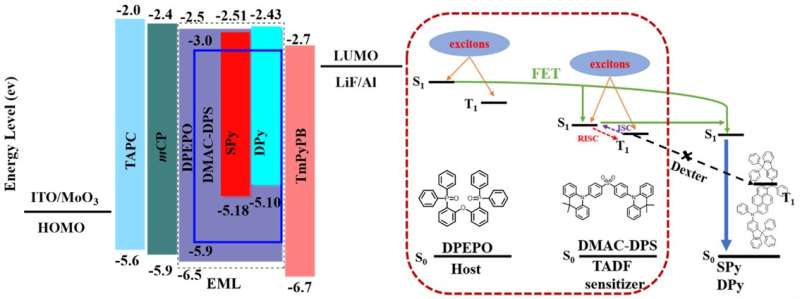A sensitization strategy achieves hyperfluorescence

Organic light-emitting diodes (OLEDs) play an important role in new-generation flat-panel displays. For ultra-high-definition displays presented in International Telecommunication Union (ITU) Recommendation BT 2020 standard, the emitter is required to be high color purity with narrow full width at half-maximum (FWHM).
However, only the 25% singlet excitons are luminescent limits the application of fluorescent OLEDs. Recently, several approaches to improve exciton utilization in fluorescent molecules have been put forward, which are collectively called "hyperfluorescence". Among them, the sensitization strategy using thermally activated delayed fluorescence (TADF) sensitizer is an effective method to obtain efficient electroluminescent devices.
Researchers led by Prof. Lei Wang at Huazhong University of Science and Technology (HUST), China, are interested in blue fluorescent OLEDs. With the aim of developing fluorescent materials suitable for TADF sensitized devices, the researchers designed and synthesized two new fluorescent emitters.
The emitters exhibited a small Stokes shift of 29 nm demonstrating that the geometrical relaxation between the ground state and the excited state can be restrained due to the introduction of 9,9-diphenyl-N-phenyl-9H-fluoren-2-amine bilaterally. Consequently, high external quantum efficiency (EQE) over 10% is achieved by the electroluminescent device with a large spectral overlap between emitter and sensitization.
The emitters also obtain a short-range charge density shift resulting in narrow emission bands due to conjugated structure interrupted by the N atom with SP3 hybridized orbital. The new molecular design strategy will be beneficial for the exploration of highly efficient fluorescent emitters.
The paper is published in the journal Frontiers of Optoelectronics.
More information: Yalei Duan et al, A sensitization strategy for highly efficient blue fluorescent organic light-emitting diodes, Frontiers of Optoelectronics (2022). DOI: 10.1007/s12200-022-00046-z
Provided by Higher Education Press




















